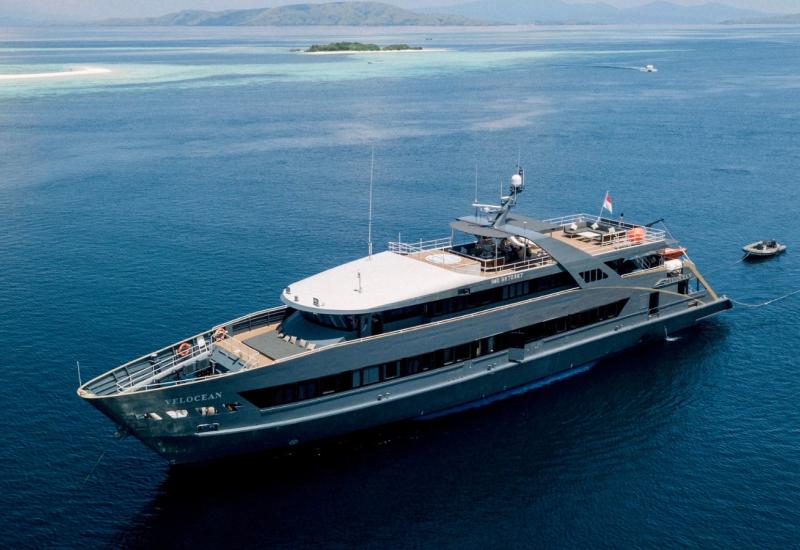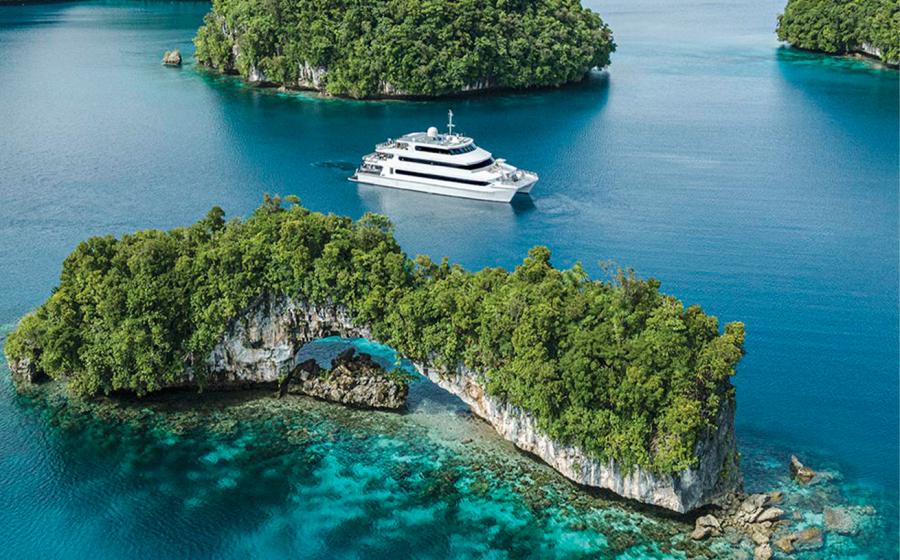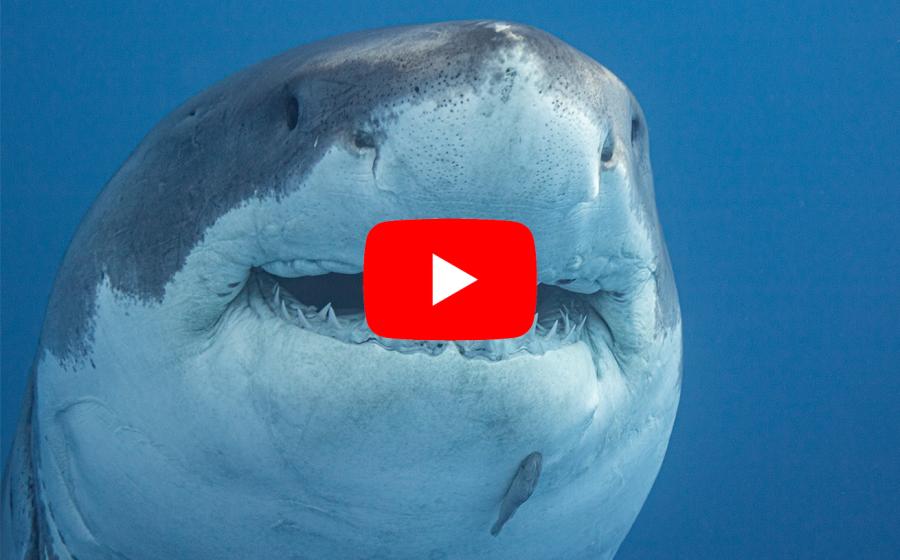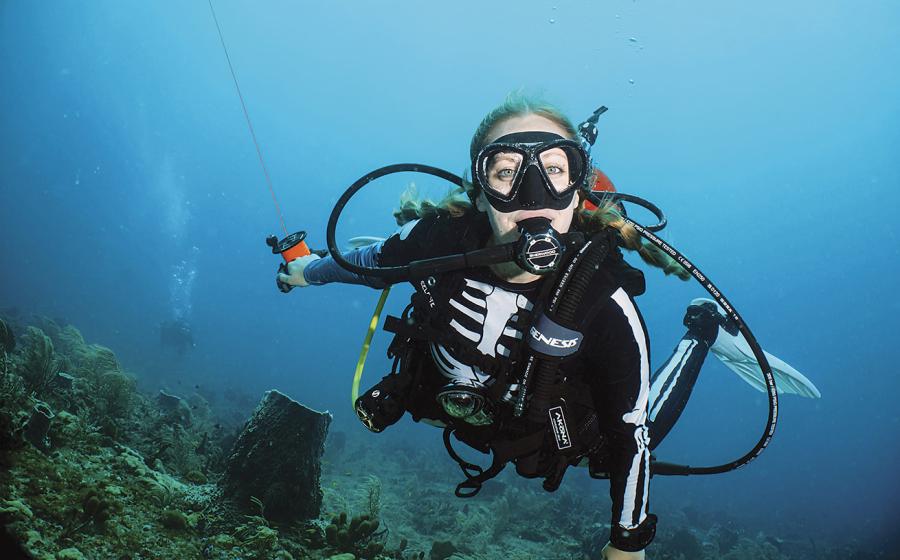Looking for Mr. Little: 20 Amazing Macro Photos
I shared a gallery a few months ago that was all about Meeting Mr Big. Whale sharks, manta rays, sea lions, hammerheads, dolphins, turtles — seeing any of these animals is a thrill for any diver.
I’ll admit that as a new diver, and later as a new photographer, I was totally into the big scenic picture and big-animal encounters, and I really had no idea of, nor much interest in, all the tiny creatures that can be found while diving.
It wasn’t until a trip to Bali, Indonesia, in 2008 that I really started to groove on finding and shooting macro subjects. Bali was my first deliberate experience of diving on mucky sites, and I will admit that at first glance, I was disappointed. Muck sites generally are not beautiful as they typically have flat or gently sloping terrain, are covered by fine silt, rubble or sand, and any coral life is limited to small outcroppings that occasionally pop up in what otherwise looks like a bit of a wasteland. But oh, what little jewels can be seen in that muck — shrimps and crabs and blennies and gobies and nudibranchs and little eels and all sorts of other intriguing stuff.
So here is the thing — unless you have great eyes (and I surely don’t), it is difficult to see the incredible details on the little stuff unless you can look through a macro lens on a camera, or through a magnifying glass. So here is a tip — if you aren’t a photographer, consider getting a good quality hand held magnifying glass with a wrist lanyard and a clip with which you can fasten it to your BC when not in use. When you find something small (hints — look for movement and color variation from the surrounding reef or muck), whip out your magnifying glass, and move in for a closer look. For the photographically inclined, adding a macro lens to your camera set up will add a whole new dimension to your photography.
One final note — an important one — in order to get in close to have a good look at/photograph these wee little creatures, excellent buoyancy control is a must. Putting your hand(s) on the reef to steady you is not acceptable, nor is touching down with your fins or any other part of your body or your gear. Tuck up your danglies — octopus regulator, gauges, hoses, pony bottle, weight belt and anything else that could rub or snag on the reef. Use your breath to keep you in position above an interesting subject. I’ve written before about how I am a fan of the muck stick for getting in close to the reef without contacting it. Used judiciously (on a bare patch on the reef, or inserted carefully in the sand), a muck stick can be used as a monopod for a large camera, a support for a diver with a digicam who can one hand it, or a pivot point for a non-photographer who wants to get in close to observe. It also can come in very handy for pushing yourself up and away from the reef without fin kicks that can cause a silt storm and/or reef damage. A muck stick should not be used as a crutch for poor buoyancy, nor be used to prod or poke or otherwise harass anything while diving.
All of the images in this gallery are of very small creatures, with the smallest that I am sharing being the Algae shrimp with eggs (some folks call it a Hairy Shrimp), which at 1/4 inch in size, is very tiny indeed. The reefs are probably thick with these otherworldly critters, as well as Skeleton shrimp (also very tiny, and which I have yet to successfully photograph), but being so small, they are not easily spotted. And most of the critters in the gallery were shot in the Indo Pacific, but little things can be found in every location — just slow down and have a closer look. Knowing where to look is half the challenge — many of the names of these creatures indicate where they can be found.
More from Judy G:
Meeting Mr. Big | Cozumel's Most Fascinating Creatures | Cold Water Rocks!
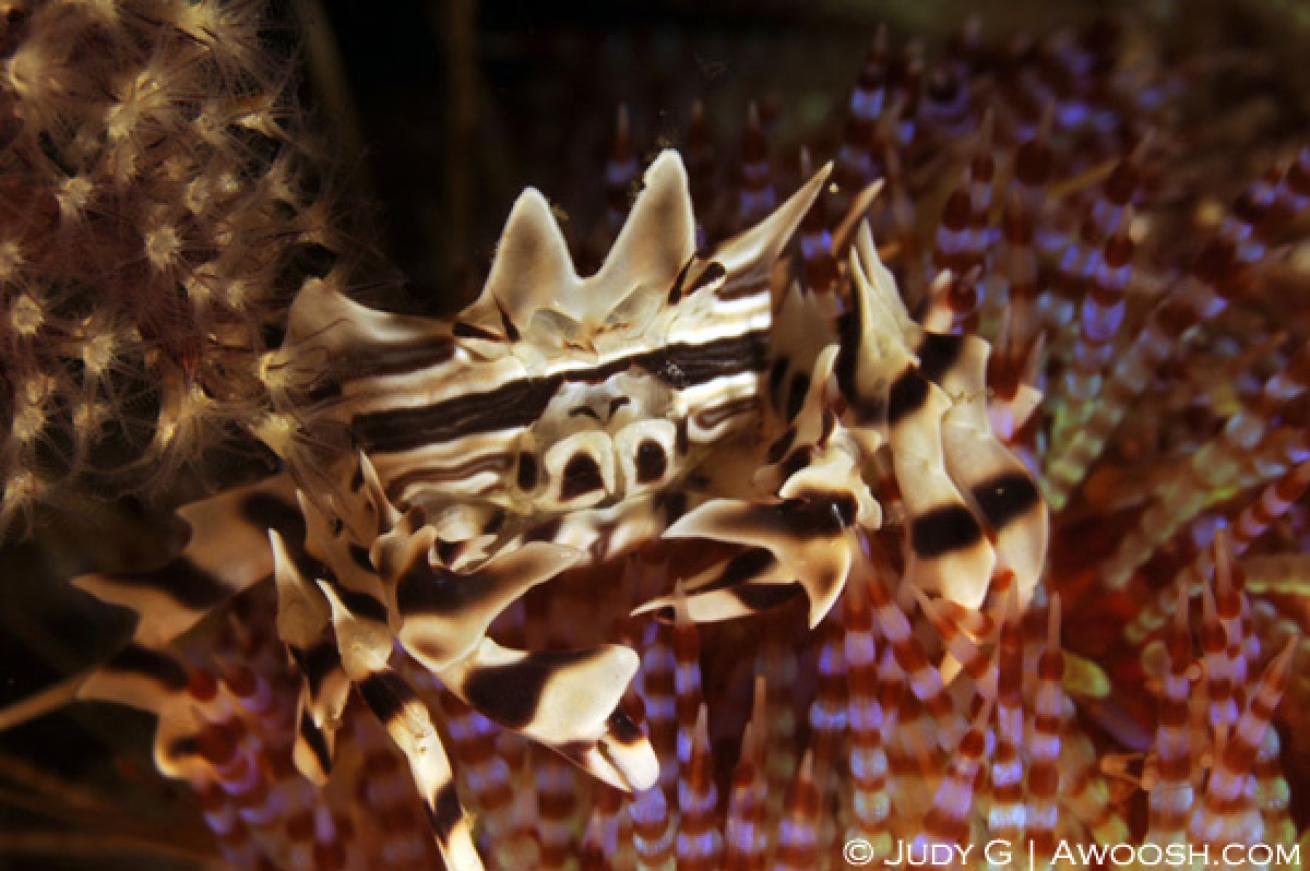
Judy G
This little beauty is found, as its name suggests, on sea urchins — specifically the wildly colorful but very toxic fire urchin.
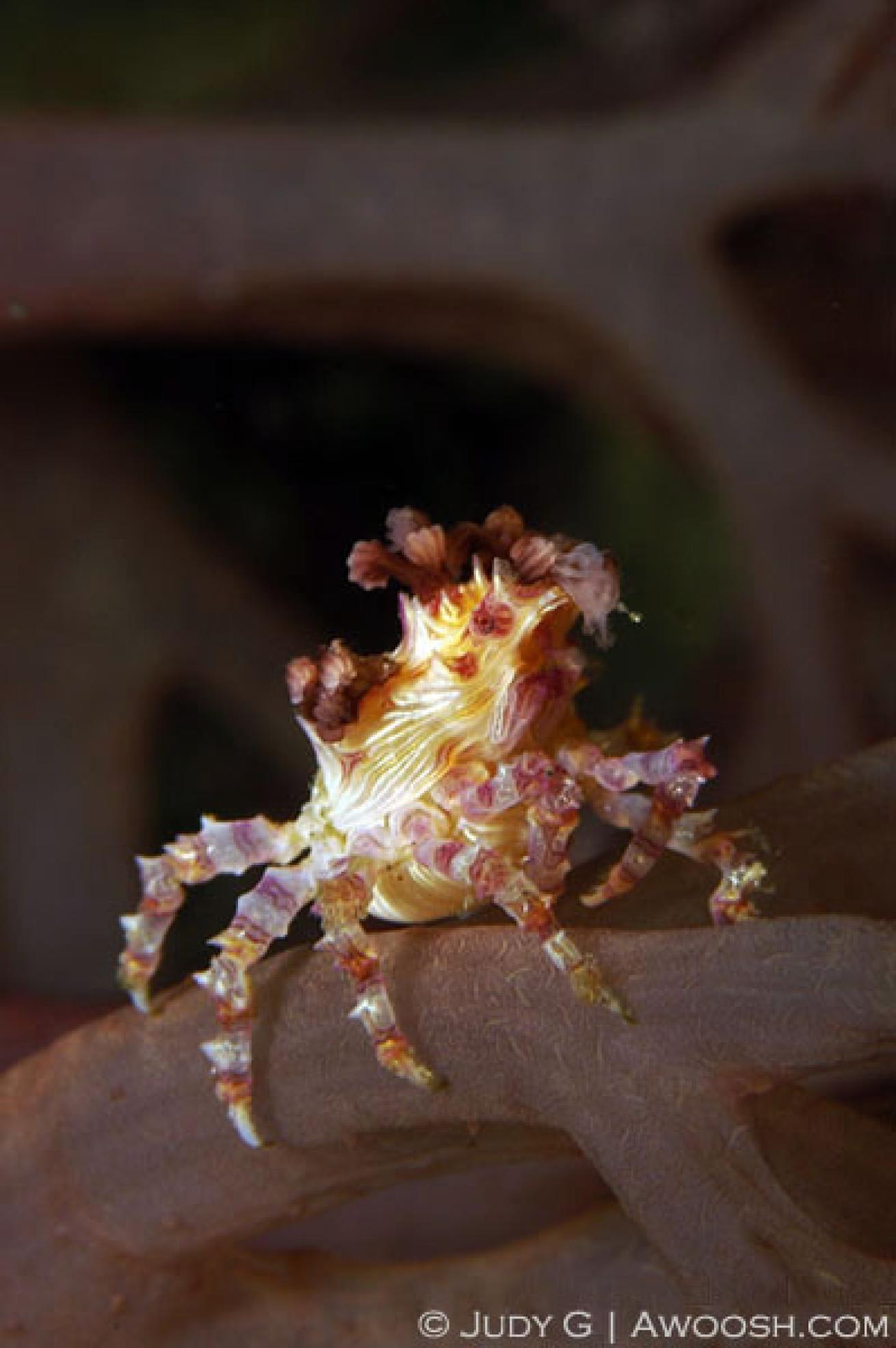
Judy G
Soft coral crabs take on the color of their host soft corals, and typically they are found hunkered down among the polyps. This little guy was out for a stroll on the stem, so he was much easier to spot and photograph.
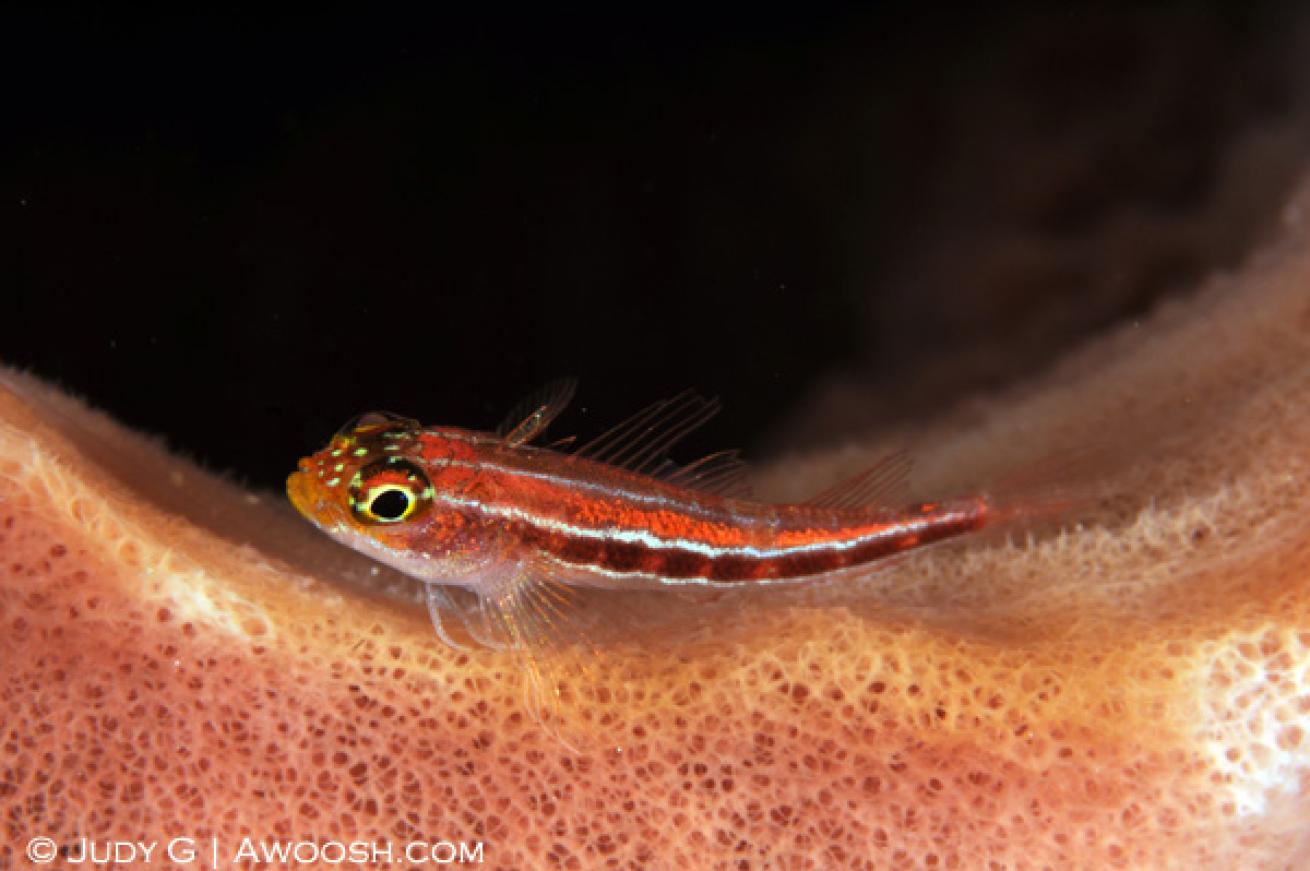
Judy G
These common little fish can be confounding to photograph as they are quite skittish. This little guy is perched on a pretty pink sponge.
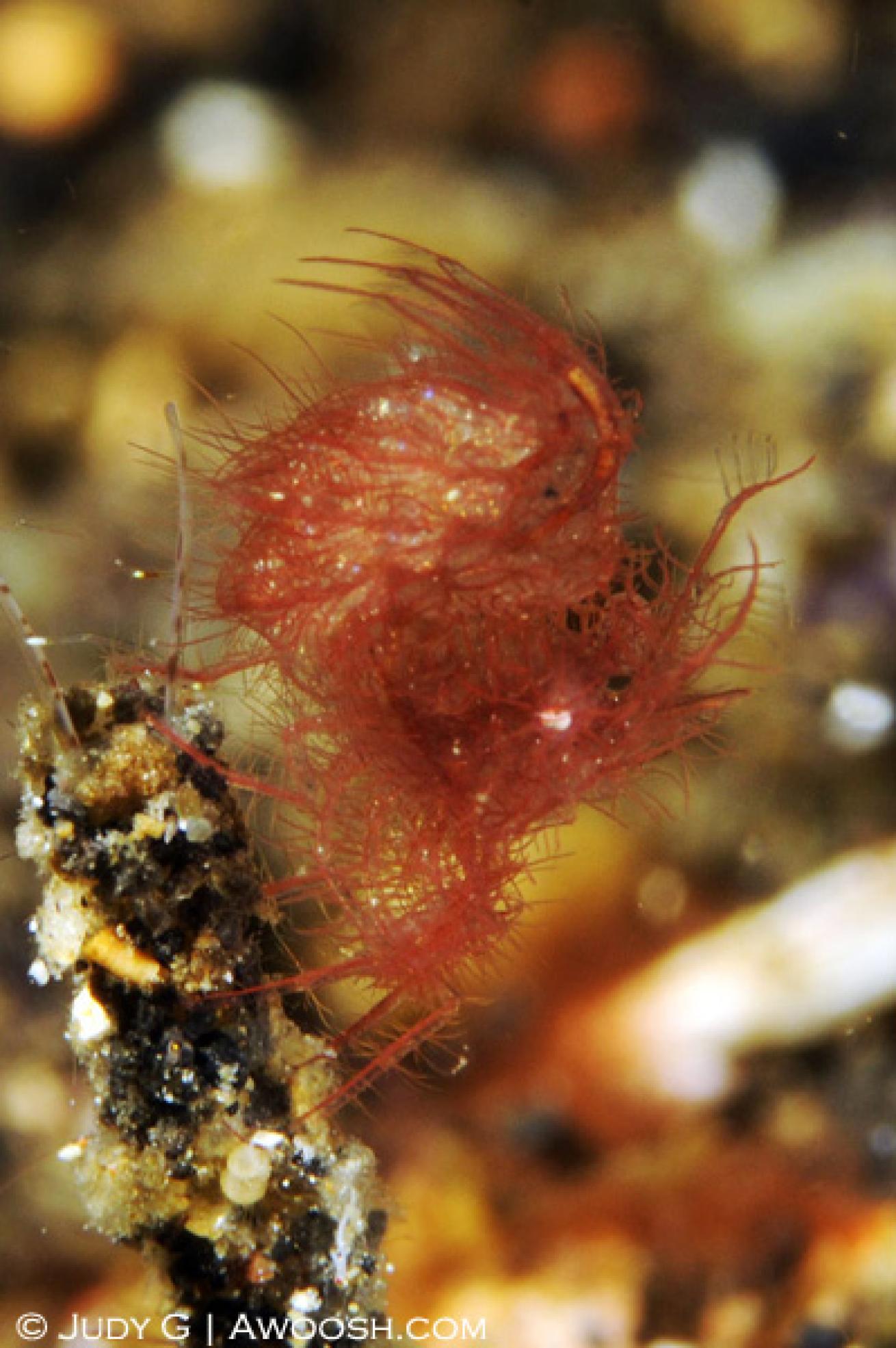
Judy G
As I mentioned in my write up, these Algae shrimp are super tiny. I would never have seen this one (with eggs!) without the help of an eagle-eyed spotter and being able to look at it through my macro lens on my camera.
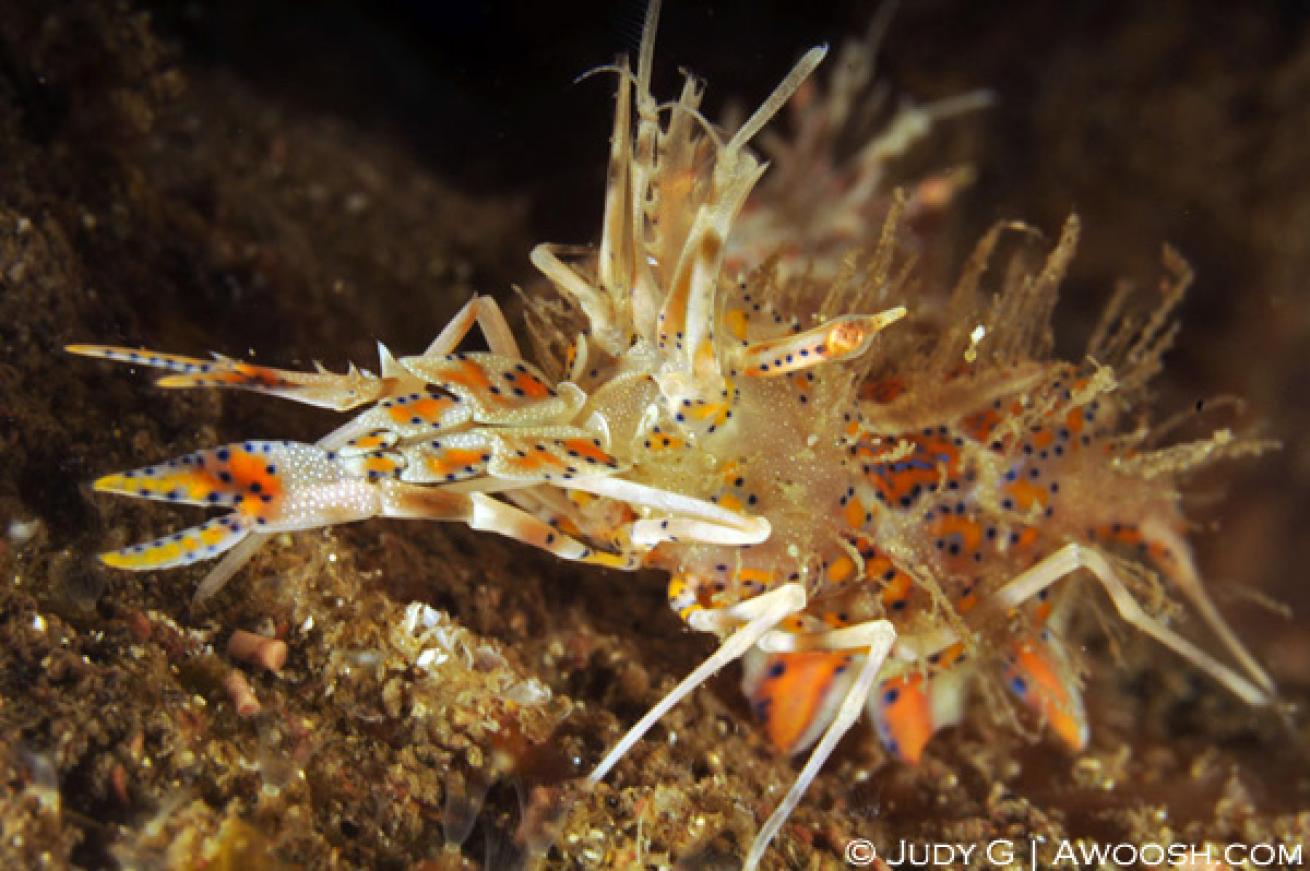
This is a fairly rarely spotted shrimp — I’ve only seen a couple of them in all of my dives. They are often seen in pairs (this one’s partner is perched behind it).
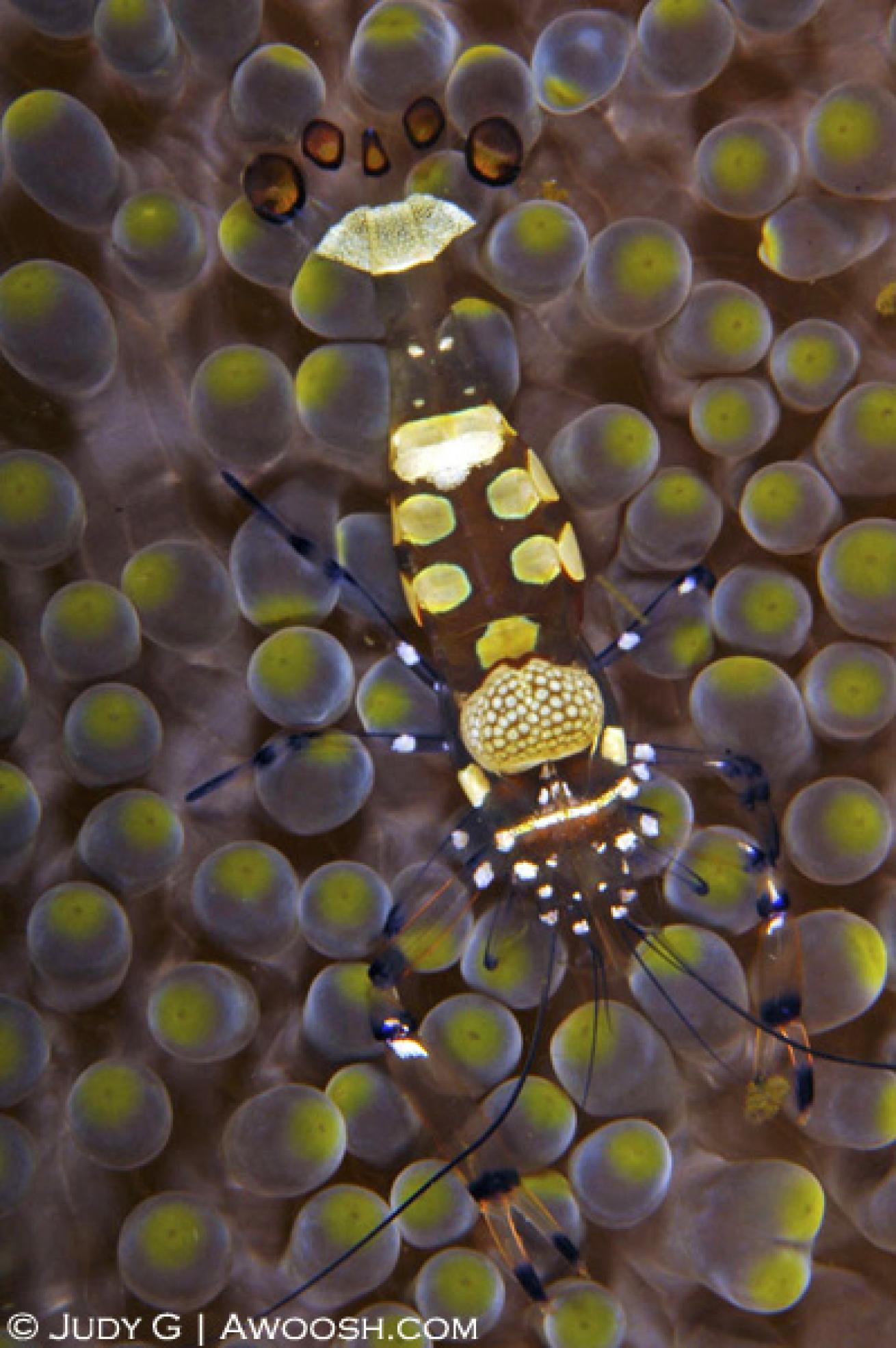
Judy G
As its name suggests, this pretty shrimp can be found on sea anemones. In both the Caribbean and the Tropical Pacific it is worth having a close look at anemones – there is almost always some sort of shrimp in residence.
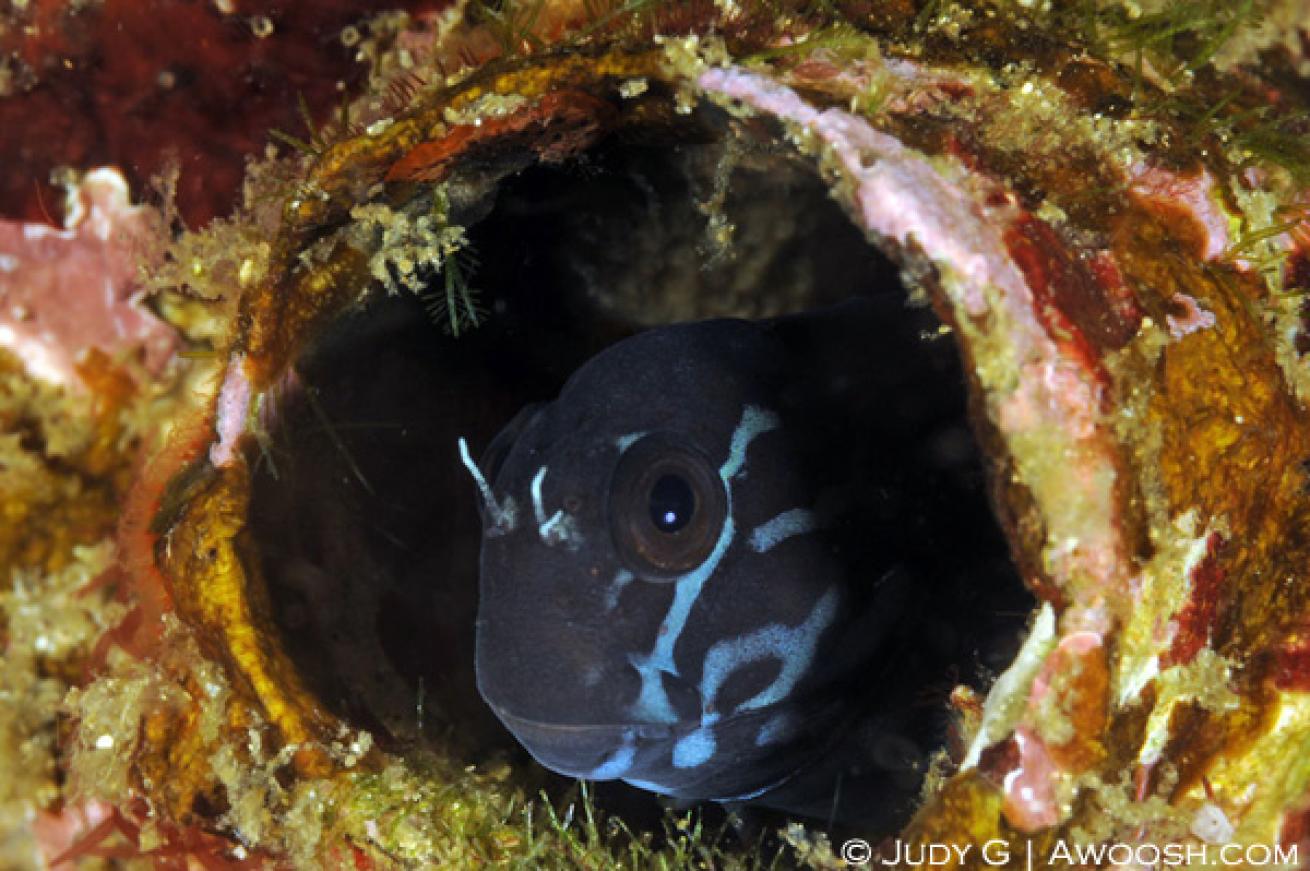
Judy G
I haven’t been able to make a positive identification for this blue-faced blennie. Its head was about half an inch in diameter. I captured this image in Komodo, Indonesia, at Cannibal Rock. Blennies typically have cute little faces and can be fun (and frustrating because they retreat into their holes!) to photograph. Having a close look at little indents and holes in coral heads or in the rocks can be rewarded with finding neat little fish like these.
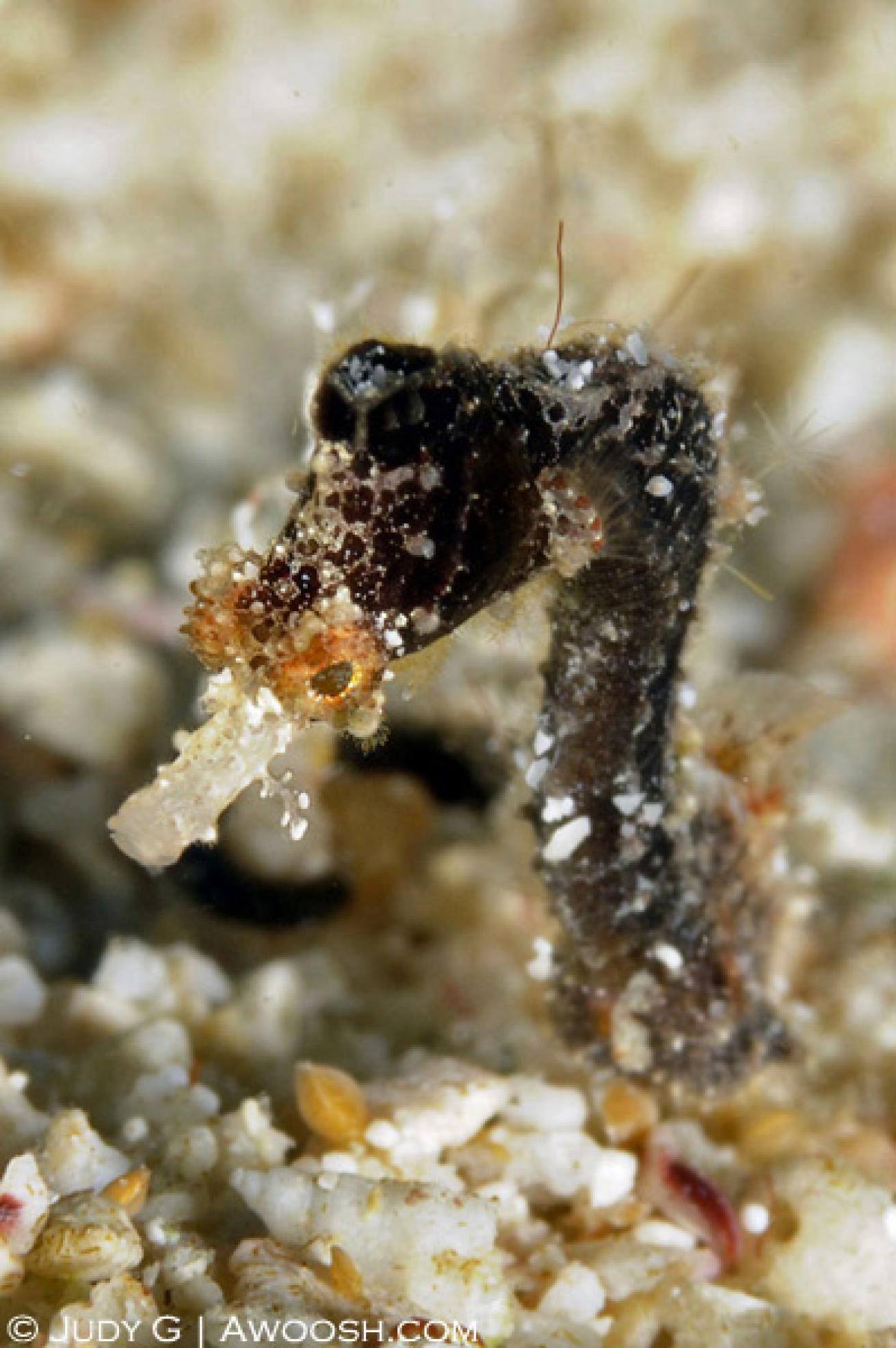
Judy G
This tiny little character, which I believe is a variety of pygmy pipehorse, was photographed in Fiji. To my bare eye, it looked like a bit of string waving in the current. I was thrilled to have a look through my macro lens and see such detail.
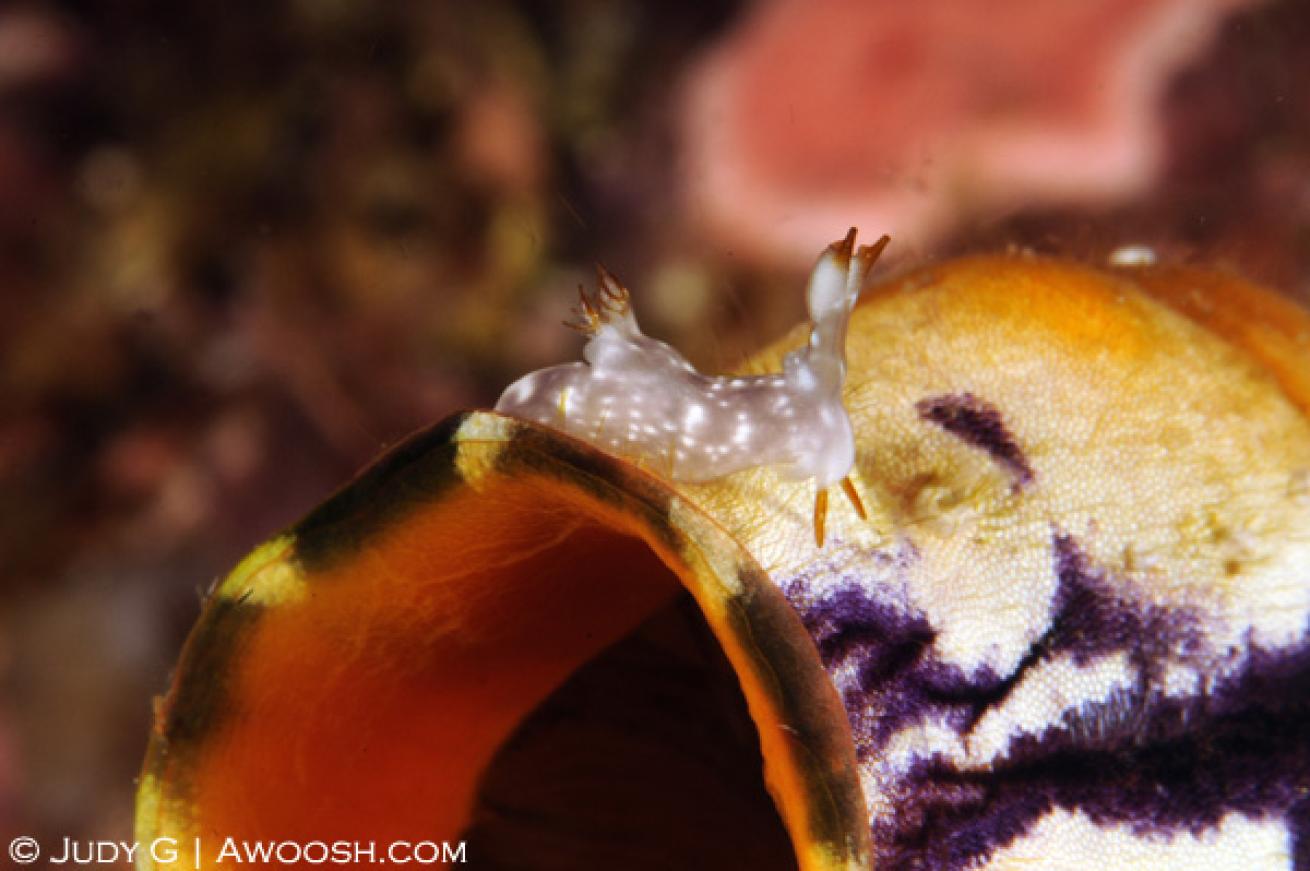
Judy G
Nudibranchs can turn up anywhere, as they tend to motate across the reef in search of their particular favorite foods. This little nudi, for which I can not make a positive identification from my resource books, is perched on the top of a colorful sea squirt.
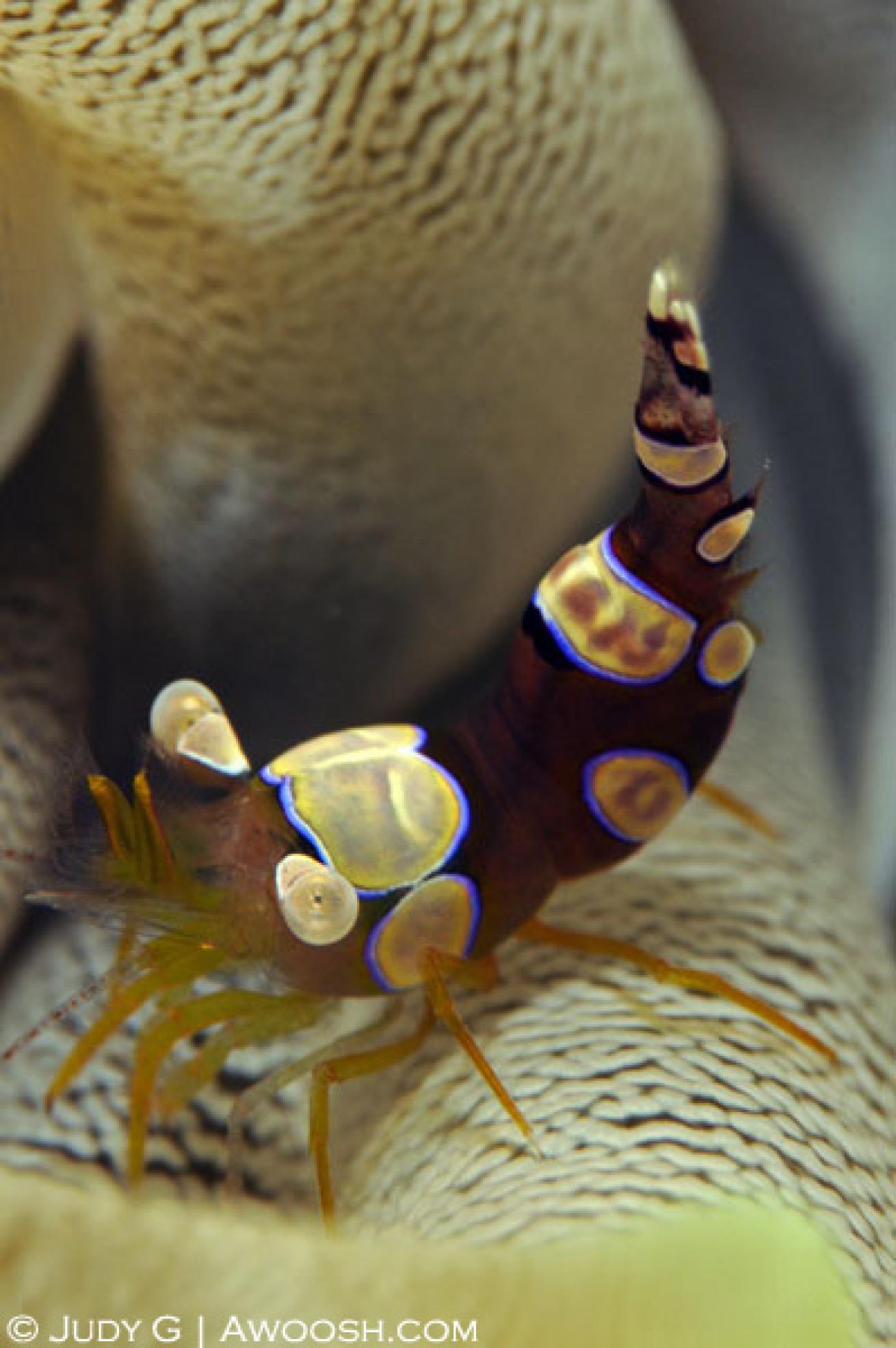
Judy G
These little shrimps are common in the Tropical Pacific and the Caribbean. I captured this image in Cozumel.
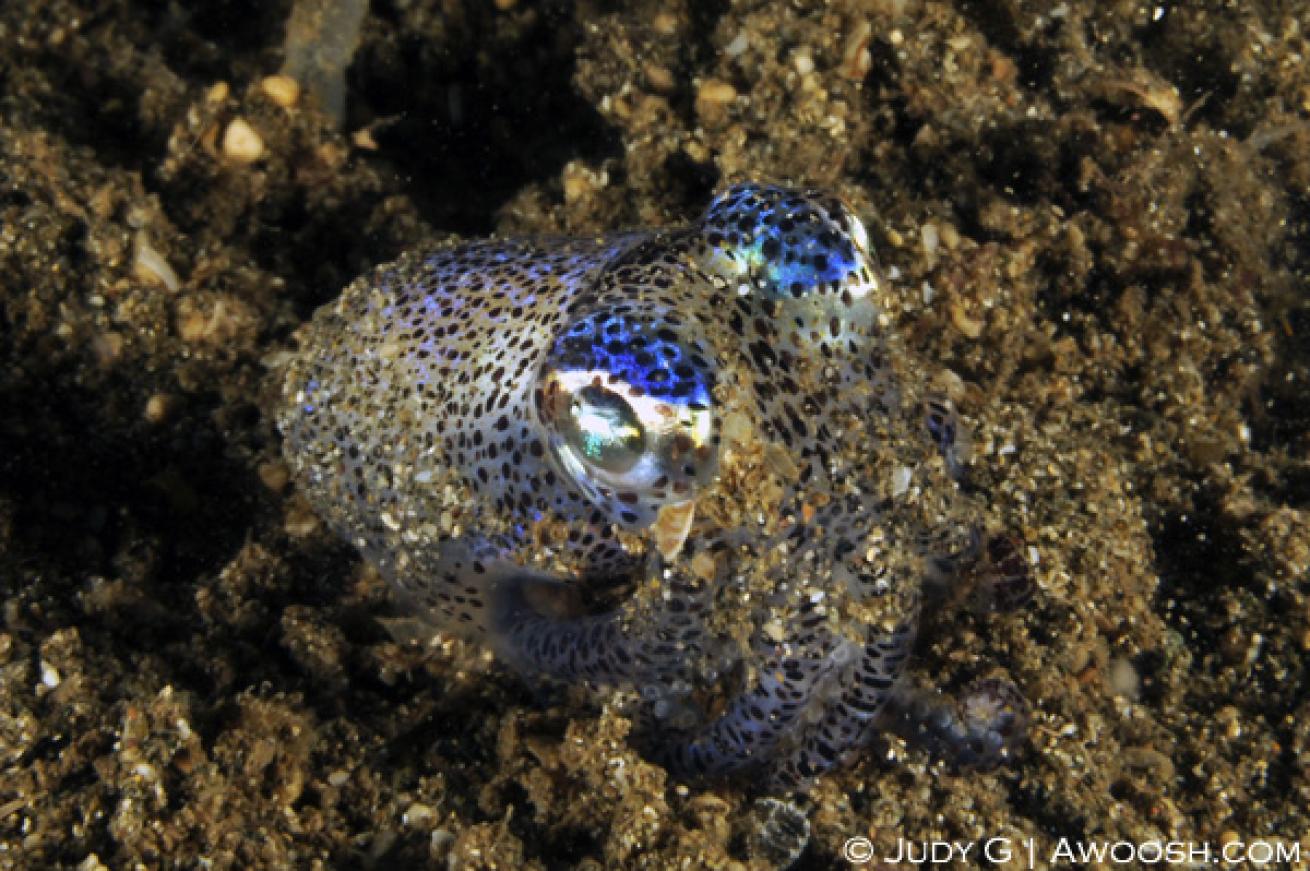
Judy G
I’ll admit I have an ongoing love affair with cephalopods. These cute little squid are usually only seen at night, and they can quickly burrow down in the sand, making them quite difficult to photograph.
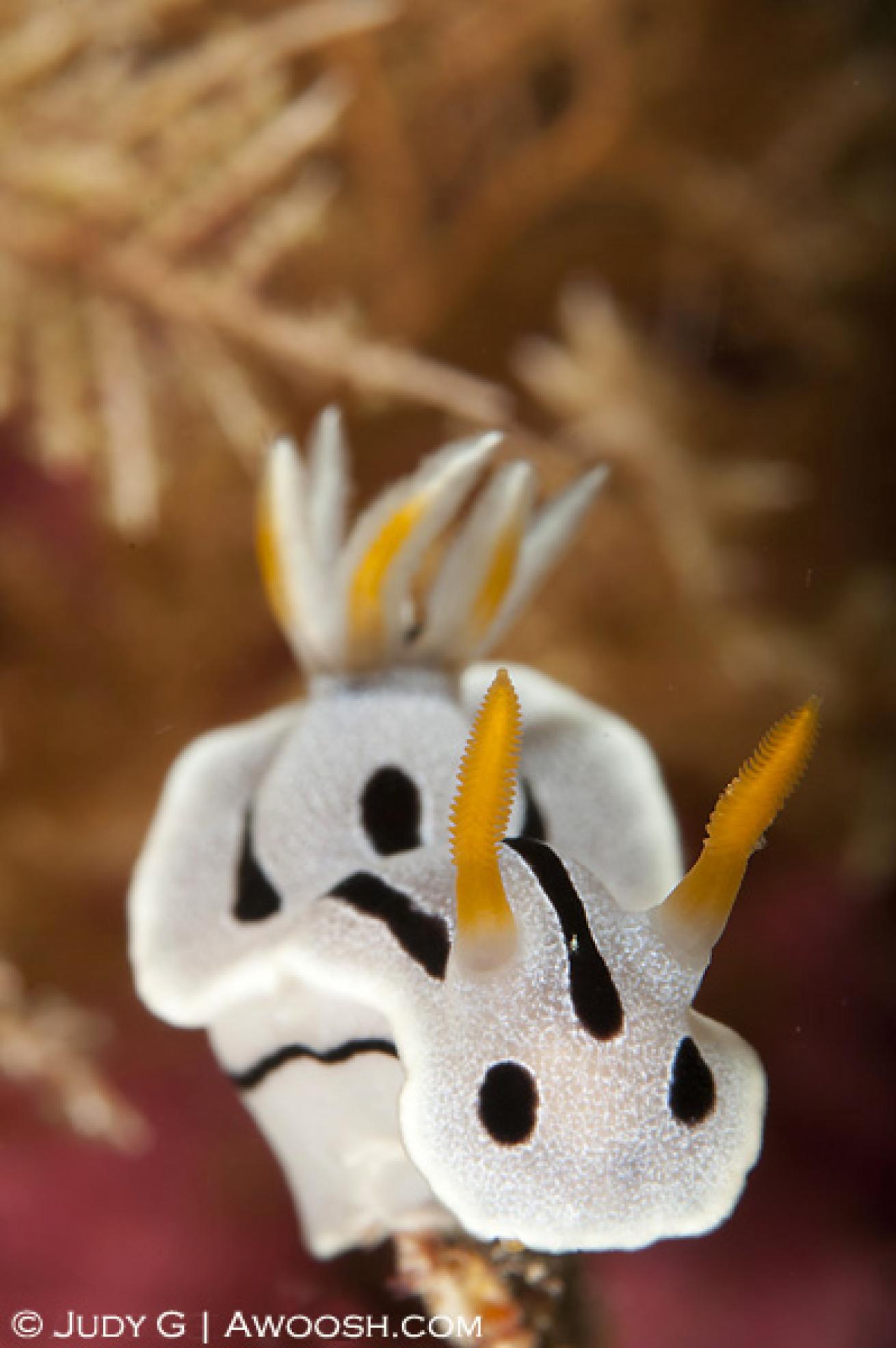
Judy G
This is a fairly common variety of nudibranch. From a distance, it just looks like a bit of white on the reef, but when seen up close, the amazing detail becomes apparent.
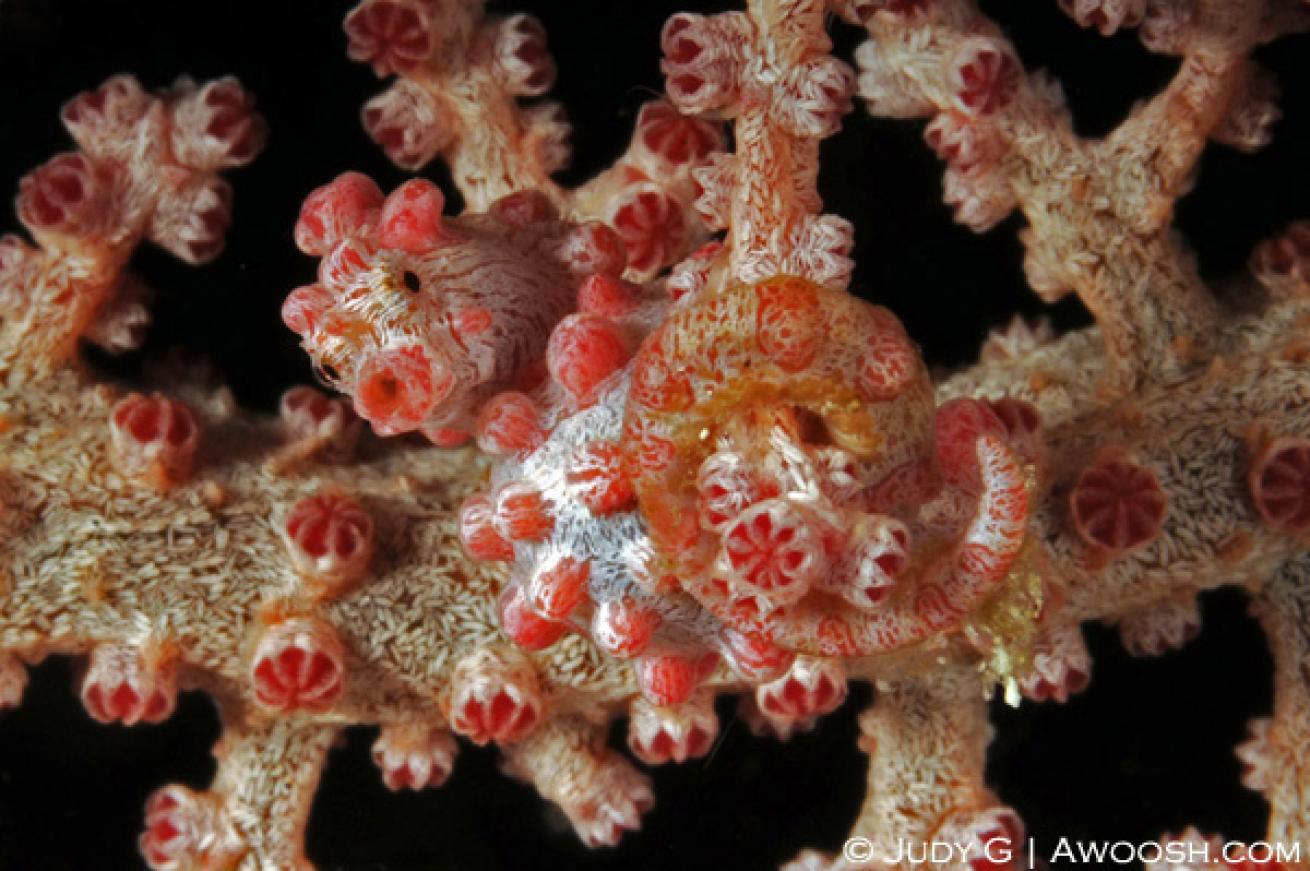
These tiny sea horses (this one about the size of a cooked grain of rice) have become very popular photographic subjects. They live their lives on a gorgonian sea fan, and, once discovered, they really have no escape from the paparazzi. Great care should be taken when photographing these creatures as the sea fans are very brittle and easily damaged, and the seahorses are apparently disturbed by the strong light from strobes.
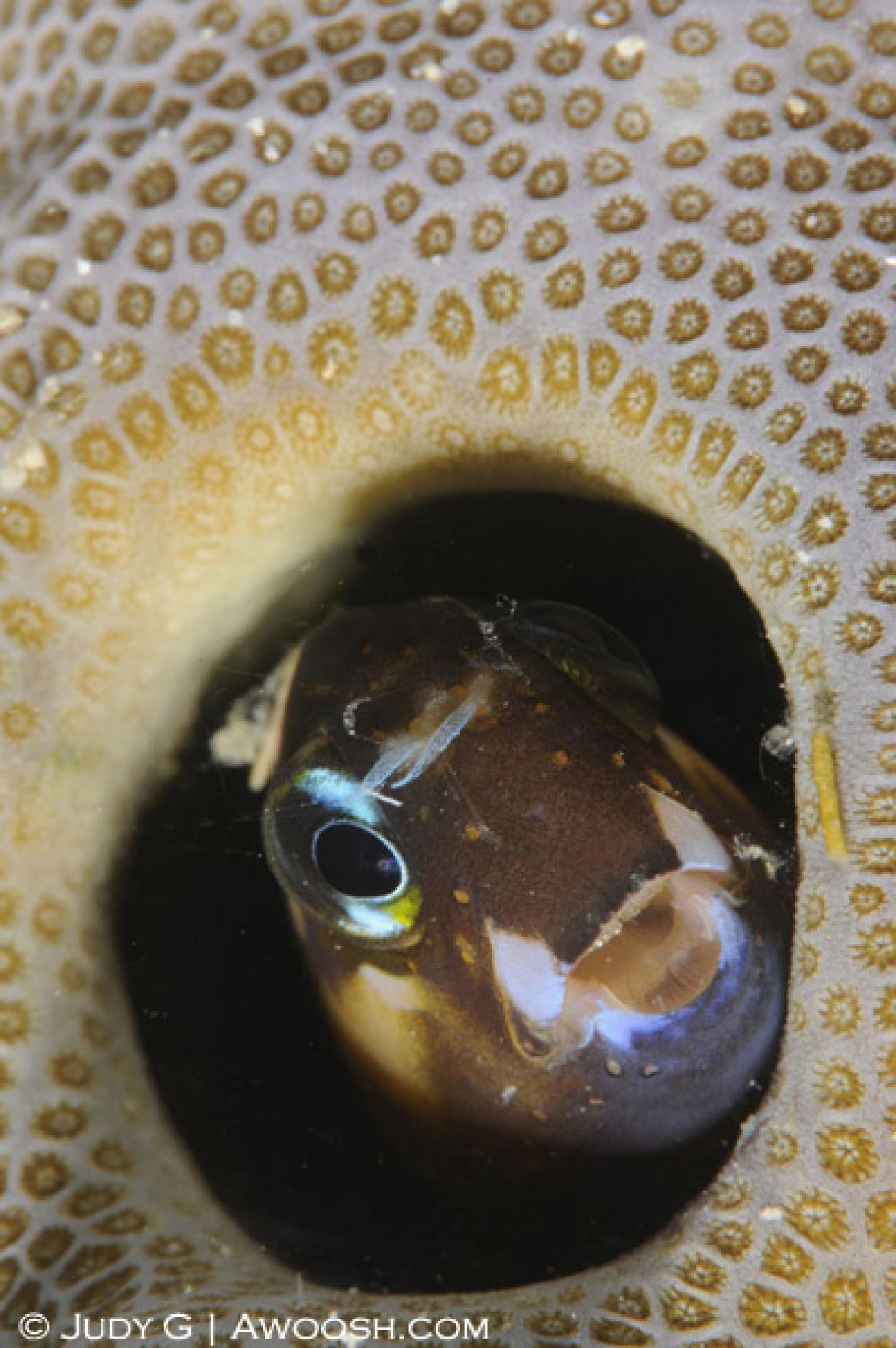
Judy G
Here is another blenny that I am not able to identify, but I share it to again demonstrate why it is worth slowing down and having a closer look at the reef for small, lively reef dwelling creatures such as these.
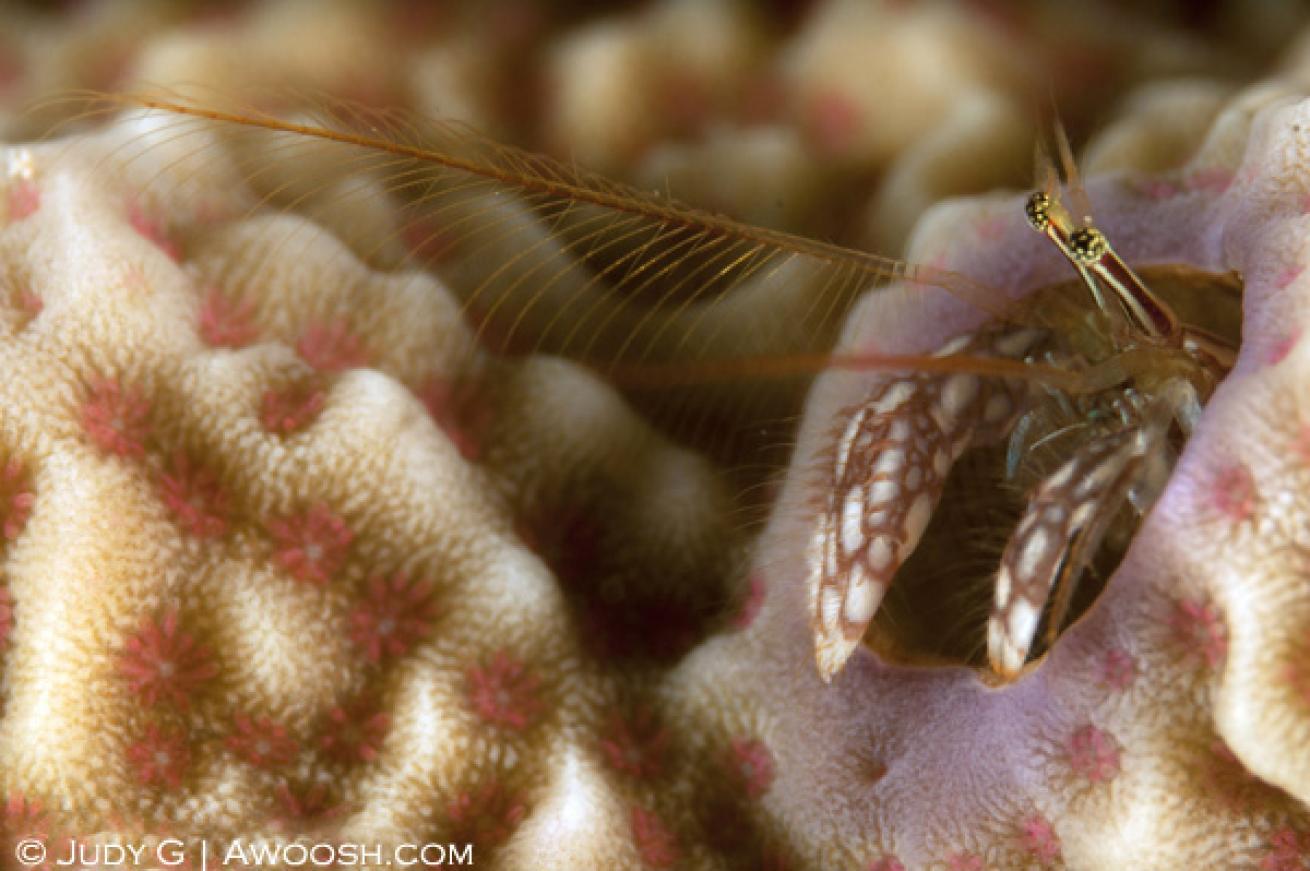
Judy G
As its name suggests, coral hermit crabs live in corals — most often boulder types. Almost impossible for me to see with my lousy eyes, I look for a bit of motion (as they deploy their feather-like appendages to sweep the water for plankton), and then focus in with the macro lens to really see them.
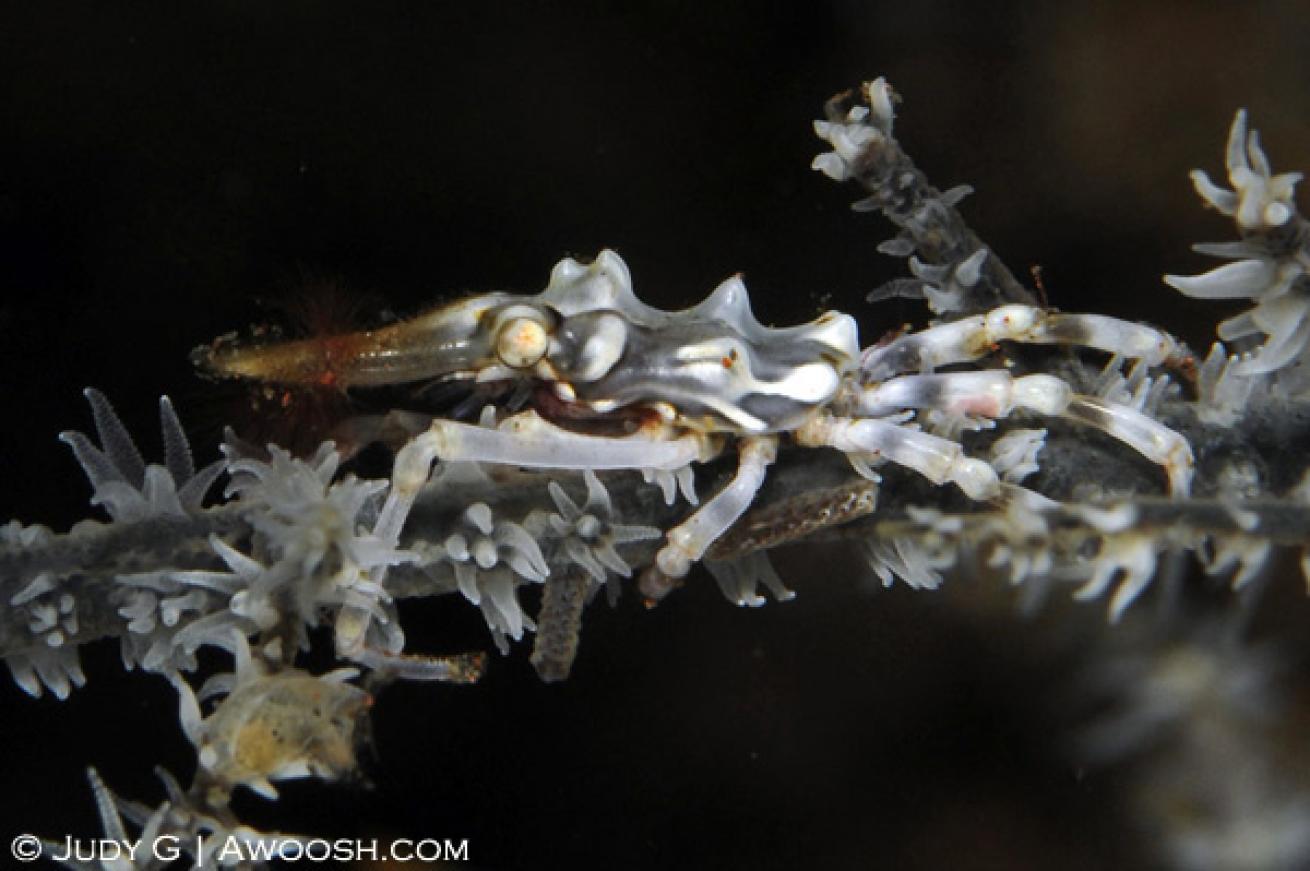
Judy G
It is worth having a good look at every wire coral, for often there are resident coral crabs like this one, wire coral blennies, and wire coral shrimp.
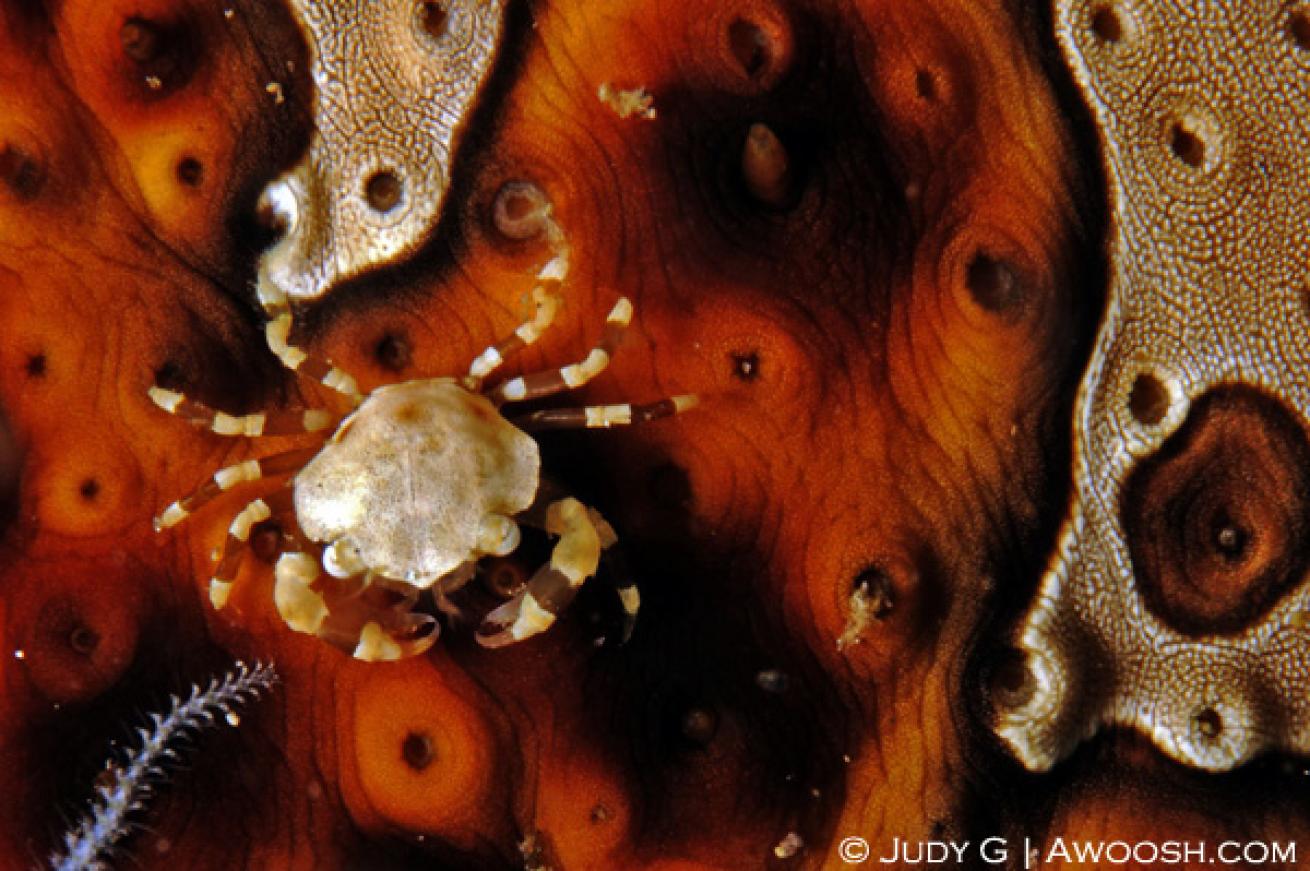
Judy G
In Asia, divers tend to look closely at sea cucumbers in the hopes of seeing the very colorful (and tiny!) Emperor shrimp. But these little swimming crabs also make their homes on (and in) sea cucumbers. I had quite a giggle on a night dive watching this little crab journey in and out of the anus of the cucumber repetitively.
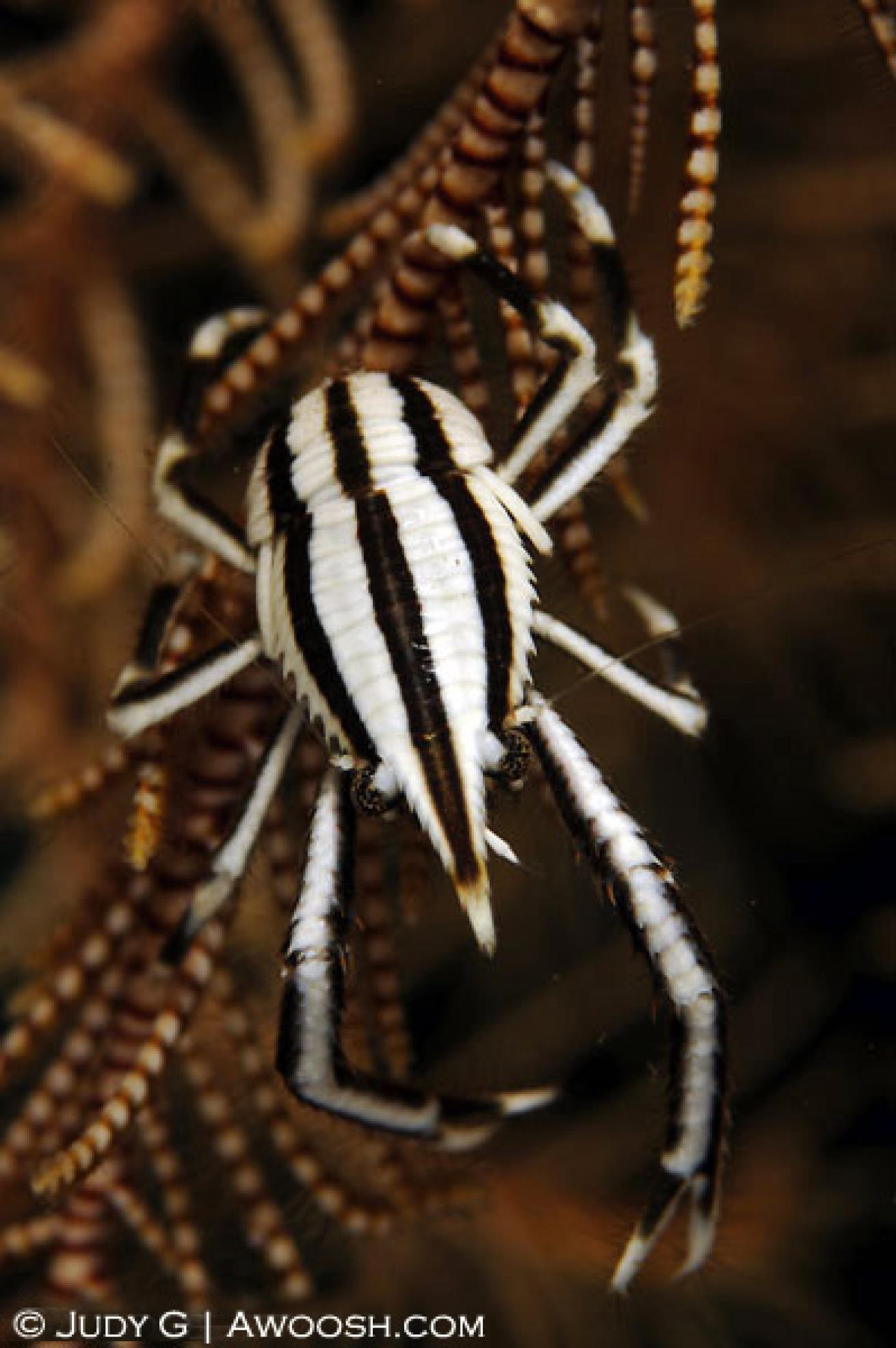
Judy G
Crinoids are creepy critters — they look very fern-like and are often seen attached to the reef with their legs, but they are also capable of free swimming, and truly look like some sort of alien species when they motate through the water. Crinoids are hosts for both squat lobsters and shrimps.
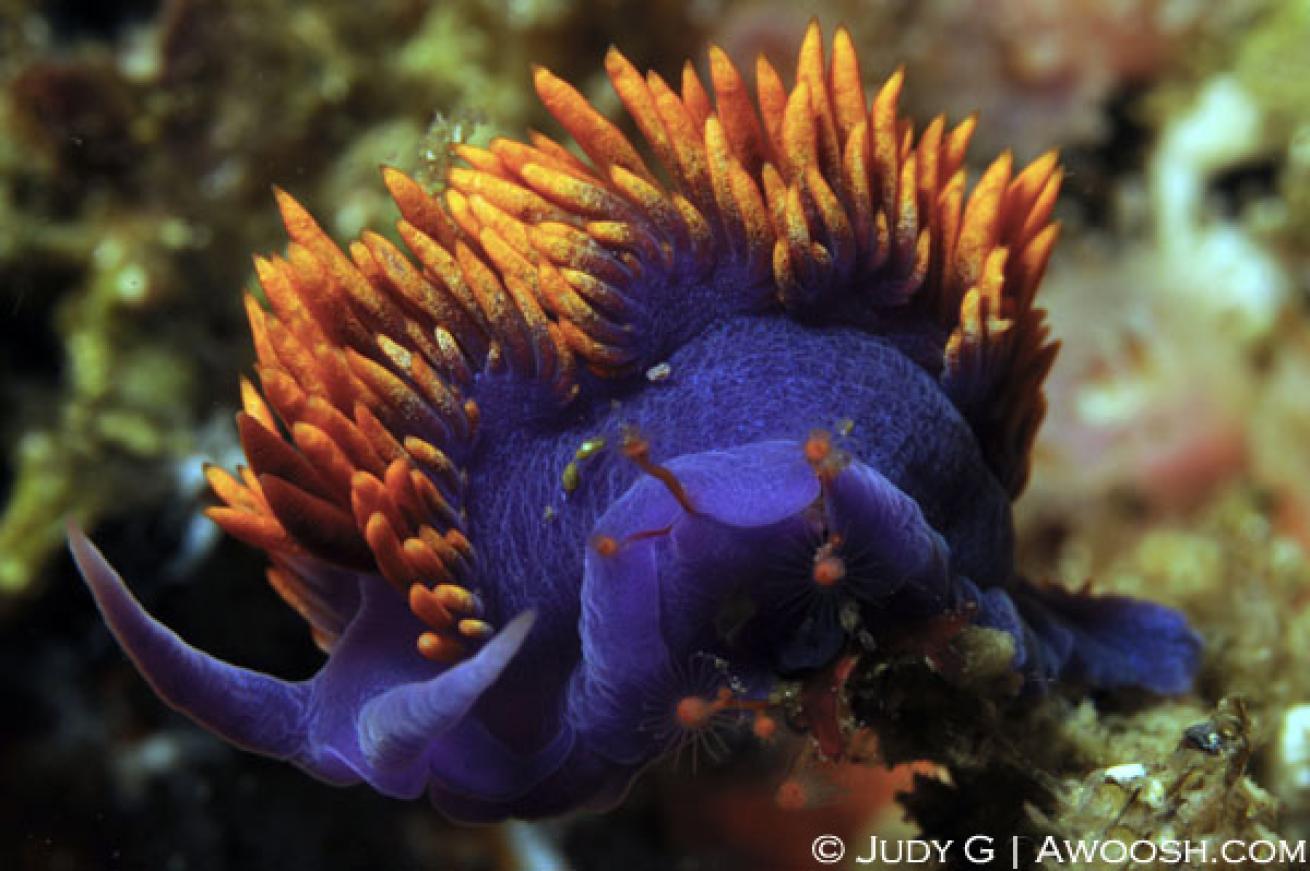
Judy G
This beautiful nudibranch (which I shot in California) is quite easy to spot due to its bright coloration and the movement of its neon orange cerrata in current.
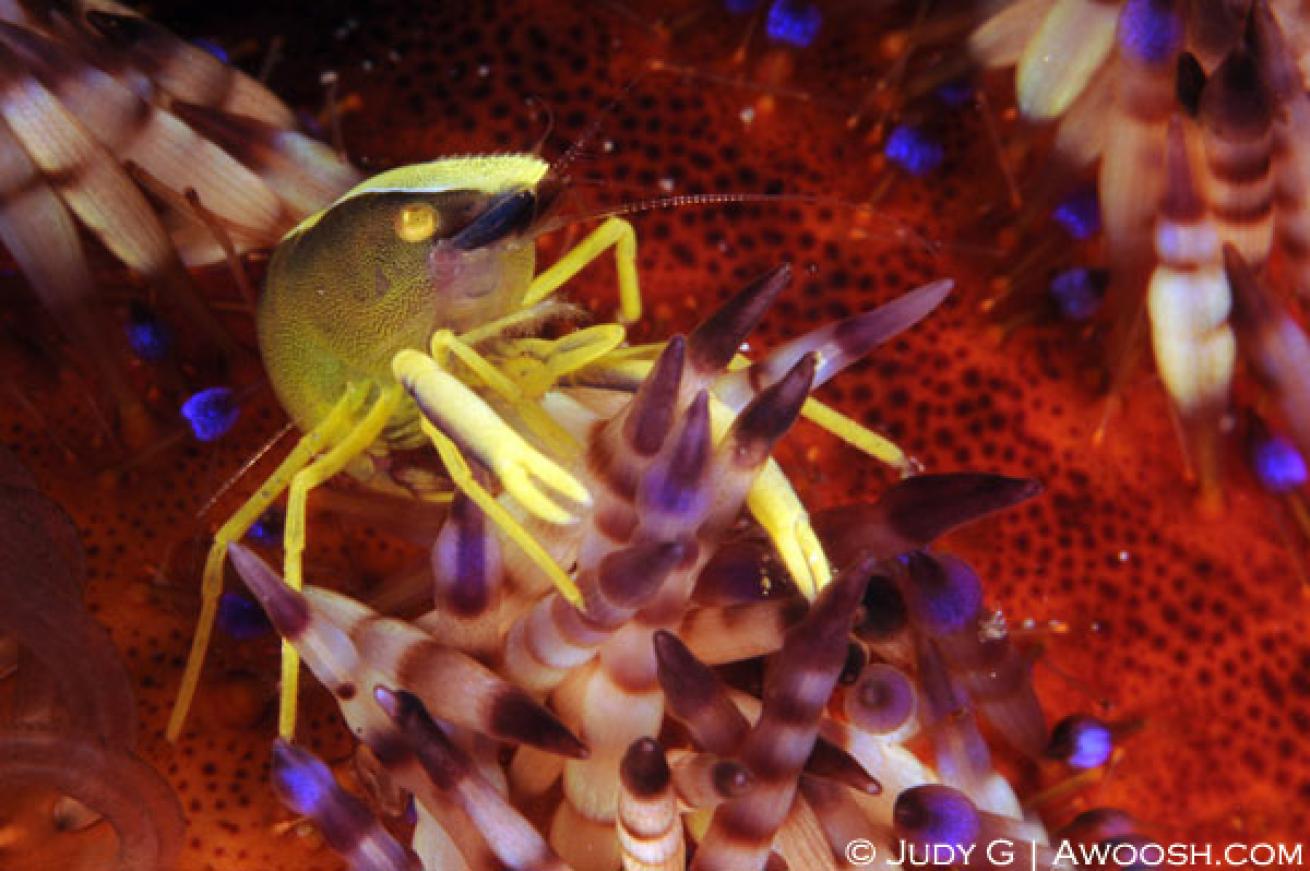
Judy G
Another fire urchin-dwelling critter, these little shrimps hide among the colorful (and toxic!) spines.
I shared a gallery a few months ago that was all about Meeting Mr Big. Whale sharks, manta rays, sea lions, hammerheads, dolphins, turtles — seeing any of these animals is a thrill for any diver.
I’ll admit that as a new diver, and later as a new photographer, I was totally into the big scenic picture and big-animal encounters, and I really had no idea of, nor much interest in, all the tiny creatures that can be found while diving.
It wasn’t until a trip to Bali, Indonesia, in 2008 that I really started to groove on finding and shooting macro subjects. Bali was my first deliberate experience of diving on mucky sites, and I will admit that at first glance, I was disappointed. Muck sites generally are not beautiful as they typically have flat or gently sloping terrain, are covered by fine silt, rubble or sand, and any coral life is limited to small outcroppings that occasionally pop up in what otherwise looks like a bit of a wasteland. But oh, what little jewels can be seen in that muck — shrimps and crabs and blennies and gobies and nudibranchs and little eels and all sorts of other intriguing stuff.
So here is the thing — unless you have great eyes (and I surely don’t), it is difficult to see the incredible details on the little stuff unless you can look through a macro lens on a camera, or through a magnifying glass. So here is a tip — if you aren’t a photographer, consider getting a good quality hand held magnifying glass with a wrist lanyard and a clip with which you can fasten it to your BC when not in use. When you find something small (hints — look for movement and color variation from the surrounding reef or muck), whip out your magnifying glass, and move in for a closer look. For the photographically inclined, adding a macro lens to your camera set up will add a whole new dimension to your photography.
One final note — an important one — in order to get in close to have a good look at/photograph these wee little creatures, excellent buoyancy control is a must. Putting your hand(s) on the reef to steady you is not acceptable, nor is touching down with your fins or any other part of your body or your gear. Tuck up your danglies — octopus regulator, gauges, hoses, pony bottle, weight belt and anything else that could rub or snag on the reef. Use your breath to keep you in position above an interesting subject. I’ve written before about how I am a fan of the muck stick for getting in close to the reef without contacting it. Used judiciously (on a bare patch on the reef, or inserted carefully in the sand), a muck stick can be used as a monopod for a large camera, a support for a diver with a digicam who can one hand it, or a pivot point for a non-photographer who wants to get in close to observe. It also can come in very handy for pushing yourself up and away from the reef without fin kicks that can cause a silt storm and/or reef damage. A muck stick should not be used as a crutch for poor buoyancy, nor be used to prod or poke or otherwise harass anything while diving.
All of the images in this gallery are of very small creatures, with the smallest that I am sharing being the Algae shrimp with eggs (some folks call it a Hairy Shrimp), which at 1/4 inch in size, is very tiny indeed. The reefs are probably thick with these otherworldly critters, as well as Skeleton shrimp (also very tiny, and which I have yet to successfully photograph), but being so small, they are not easily spotted. And most of the critters in the gallery were shot in the Indo Pacific, but little things can be found in every location — just slow down and have a closer look. Knowing where to look is half the challenge — many of the names of these creatures indicate where they can be found.
More from Judy G:
Meeting Mr. Big | Cozumel's Most Fascinating Creatures | Cold Water Rocks!




